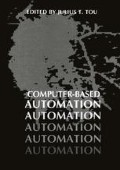Abstract
In a mechanical CAD/CAM system the 3D geometric structure of parts have to be specified. There are two classes of methods for specifying the geometry of the parts, i.e., 2D-oriented and 3D-oriented. In the first class we examine the methods of representing the mechanical part by an engineering drawing with the top, front, and side views in orthographic projection. We shall propose a system which automatically interprets the engineering drawing by employing image processing techniques and derives the 3D geometry of the part from the 2D views.
Next, the class of 3D-oriented methods for part geometric modeling if reviewed. In this class we shall provide a system to facilitate the user to creat and edit a 3D part, with the aid of both wire frame and shaded displays.
Access this chapter
Tax calculation will be finalised at checkout
Purchases are for personal use only
Preview
Unable to display preview. Download preview PDF.
References
T. Kanade, “Recovery of the three-dimensional shape of an object from a single view,” Artificial Intelligence 17, pp. 409–460, 1981.
J. K. Udupa, “Determination of 3D shape parameters from boundary information,” Computer Graphics and Image Processing 17, pp. 52–59, 1981.
S. Lobregt, P. W. Verbeek, and F. C. A. Groen, “Three-dimensional skeletonization: principle and algorithm,” IEEE Trans. on Pattern Analysis and Machine Intelligence, No. 1, pp. 75–77, Jan. 1980.
M. Ejiri, T. Uno, H. Yoda, T. Goto, and K. Takeyasu, “A prototype intelligent robot that assemblies object from plan drawings,” IEEE Trans. on Computer, vol. C-21, No. 2, pp. 161–170, 1972.
M. Idesawa, T. Soma, E. Goto, and S. Shibata, “Automatic input of line drawing and generation of solid figure from three-view data,” in Proc. Int. Comput. Symp., vol. 2, pp. 304–311, 1975.
G. Lafue, “Recognition of three-dimensional objects from orthographic views,” in Proc. SIGGRAPH, pp. 103–108, 1976.
M. A. Wesley and G. Markowsky, “Fleshing out projections,” IBM J. Res. Develop., vol. 25, No. 6, pp. 934–954, 1981.
G. Markowsky and M. A. Wesley, “Fleshing out wire frames,” IBM J. Res. Develop., vol. 24, No. 5, pp. 582–597, 1980.
B. Aldefeld, “On automatic recognition of 3D structures from 2D representations,” Computer Aided Design, vol. 15, No. 2, pp. 59–64, March 1983.
A. A. G. Requicha and H. B. Voelcker, “Solid modeling: a historical summary and contemporary assessment,” IEEE CG andamp; A, pp. 9–23, March 1982.
A. A. G. Requicha and H. B. Voelcker, “An introduction to geometric modeling and its applications in mechanical design and production,” The University of Rochester, Rochester, NY, Tech. Rep., Chapter 5, 1977.
A. A. G. Requicha, “Representations for rigid solids: theory, method, and systems,” Computing Surveys, vol. 12, No. 4, pp. 437–465, Dec. 1980.
J. W. Boyse and J. E. Gilchrist, “GMsolid: interactive modeling for design and analysis of solids,” IEEE CG and; A, pp. 27–40, March 1982.
R. Hillyard, “The build group of solid modelers, ”IEEE CG and A pp; A, pp. 43–52, March 1982.
A. Baer, C. Eastman, and M. Henrion, “Geometric modelling a survey,” CAD, vol. 11, No. 5, pp. 253–272, Sept. 1979.
I. C. Braid, “The synthesis of solids bounded by many faces,” Commun. Assoc. Comput. Mach., pp. 209–216, April 1975.
M. A. Wesley, T. Lozano-Perez, L. I. Lieberman, M. A. Lavin, and D. D. Grossman, “A geometric modeling system for automated mechanical assembly,” IBM J. Res. Develop., pp. 64–74, Jan. 1980.
D. D. Grossman, “Procedural representation of 3D objects,” IBM J. Res. Develop., pp. 582–589, Nov. 1976.
H. B. Voelcker and A. A. G. Requicha, “Geometric modeling of mechanical parts and processes,” Computer, pp. 48–57, Dec. 1977.
J. D. Foley and A. Van Dam, Fundamentals of Interactive Computer Graphics, Massachusetts: Addison-Wesley, 1982.
S. J. Joe, “3D reconstruction and graphic display of mechanical parts from orthographic drawings,” Master’s thesis, Inst. of Comput. Eng., National Chiao Tung University, Taiwan, R.O.C., 1983.
C. Y. Lo, Z. Chen, and D. B. Perng, “A CAD/CAM system for mechanical part design and production,” in Proc. Int. Conf. Adv. Automation, pp. 266–272, 1983.
Author information
Authors and Affiliations
Editor information
Editors and Affiliations
Rights and permissions
Copyright information
© 1985 Plenum Press, New York
About this chapter
Cite this chapter
Chen, Z., Perng, D.B. (1985). Computer-Assisted Methods for Defining 3D Geometric Structure of Mechanical Parts. In: Tou, J.T. (eds) Computer-Based Automation. Springer, Boston, MA. https://doi.org/10.1007/978-1-4684-7559-3_9
Download citation
DOI: https://doi.org/10.1007/978-1-4684-7559-3_9
Publisher Name: Springer, Boston, MA
Print ISBN: 978-1-4684-7561-6
Online ISBN: 978-1-4684-7559-3
eBook Packages: Springer Book Archive

